
- Home Page
- Accepted
Paintings & Copies - Doubtful
Attributions - Doubtful Textual References
- Alternative
Titles - Collectors &
Museums - Bibliography
- Search Abecedario
- Watteau &
His Circle
L’Orgueilleux
Entered February 2020
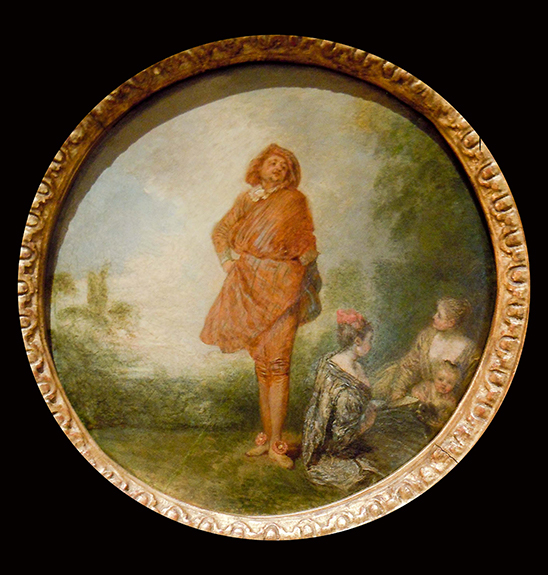
New York, private collection
Oil on panel
20 cm (diameter)
ALTERNATIVE TITLES
The Proud Man
RELATED PRINTS
L’Orgueilleux was not recorded in Jean de Jullienne’s L’Oeuvre gravé.
PROVENANCE
Collection of John Dalrymple, 2nd earl of Stair (1673-1747), prior to 1720.
By descent to John James Hamilton Dalrymple, 12th earl of Stair (1879-1961), until c. 1960.
Paris, collection of Raoul Dastrac (1891-1969; painter).
Paris, with Etienne Bréton Fine Art.
EXHIBITIONS
Zurich, Kunsthaus, Schönheit des 18. Jahrhunderts (1955), (as by Watteau, L’Orgueilleux, lent by a private collector, Paris).
Paris, Cailleux, Watteau et sa géneration (1968), cat. 41 (as by Watteau, L’Orgueilleux, lent by a private collector [Raoul Dastrac], Paris).
SELECT BIBLIOGRAPHY
Mathey, Watteau, peintures réapparues (1959), 69, cat. 134.
Macchia and Montagni, L’opera completa di Watteau (1968), cat. 121.
Ferré, Watteau, 1972, cat. B32.
Roland Michel, Watteau (1981), cat. 187.
Roland Michel, Watteau (1984), 185
“En Gros plan” (1968), 23.
Rosenberg and Prat, Watteau, Catalogue raisonné des dessins (1996), cat. 553.
Temperini, Watteau (2002), cat. 46.
Valenciennes, Musée, Watteau et la fête galante (2004), 98, 100.
Michel, «Le Celèbre Watteau» (2008), 84.
RELATED DRAWINGS
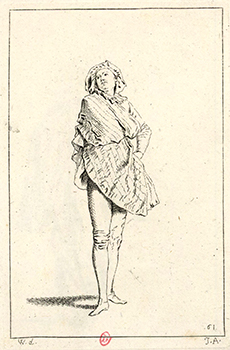
Comte de Caylus after Watteau, Standing Man with a Cape, engraving, Figures de différents caractères, plate 61.
There once was a Watteau drawing for the principal figure in L’Orgueilleux but it has not survived. However, it was recorded in an etching by the comte de Caylus and formed part of his Suite de figures inventées par Watteau et gravées par son ami C., and was then included as plate 61 in the Figures de différents caractères.
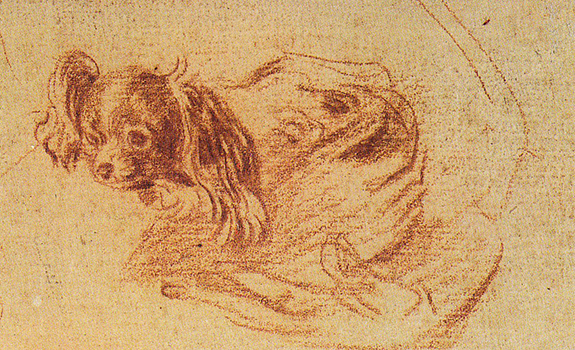
Watteau, Four Studies of a King Charles Spaniel (detail), red chalk. Fontainebleau, private collection.
The King Charles spaniel cradled in the arms of the young girl is based on a sheet of four studies of this dog, now in a Fontainebleau collection (Rosenberg and Prat 553). Watteau employed the upper right study for this painting. It should be noted that in the drawing the hands are those of an adult, and this was adjusted, of course, for the painting.
REMARKS
Because this painting descended through successive generations of the Dalryple family, it has been presumed that it originally was with John Dalrymple. 2nd earl of Stair. After the ascent of King George I to the throne in 1714, the 2nd earl of Stair was appointed as an envoy to the court of France, where he became friendly with the Regent, Philippe II, duc d’Orléans. Watteau was also a member of the Regent’s circle. Conceivably, Dalryrmple and the artist could have met there. In June 1720 Dalyrmple left his ambassadorship and returned to the United Kingdom.
This pleasant painting has received little attention from scholars. As the composition was probably not in France and was not recorded in Jullienne’s Oeuvre gravé, it went unmentioned. In the mid-nineteenth century the composition was known through a copy in the Burat collection that was thought to be from Watteau’s hand (our copy 1). But even that work quickly fell from sight. The first mention of L’Orgueillieux occurred only in the mid-twentieth century.Once Watteau’s picture came to light, it was accepted by Mathey, Ferré, Roland Michel, Macchia and Montagni, Rosenberg and Prat, Temperini, and Michel. Quite remarkably, there have been no opposing voices.
None of the scholars who have accepted the painting have commented on its tondo shape. Certainly the circular format nicely accommodates the markedly asymmetrical composition. The centrality given to the Mezzetin and the way in which the curvature of the frame embraces the women is skillful. Yet such a circular format is without parallel in Watteau’s oeuvre. There are many oval paintings, both vertical and horizontal ovals—a shape often given to early eighteenth-century paintings. But there are no circular works, not in Watteau’s oeuvre nor in the works of his satellites. Two of Watteau’s paintings, La Danse paysanne and La Cascade, were cut down into circular panels, but only in the late eighteenth century. How then are we to account for the circular nature of this panel?
The panel was examined in 2020 by conservator David Bull, who has confirmed that the painting was originally executed as a circle and that, curiously, the grain runs at a diagonal angle; had the panel been rectangular, the grain of the wood would have run either vertically or horizontally. It appears that this wood was not intended to serve for a painting but, rather, was salvaged from some other project. The artist’s use of such secondhand materials, although unorthodox, is not unheard of in Watteau’s oeuvre. Indeed, several of Watteau’s other works were painted on secondhand materials: La Leçon d’amour was painted on a carriage door, and La Surprise was executed on the reverse side of a discarded copper plate used for engraving. Yet, such evidence does not explain why Watteau chose a circular format in this instance.
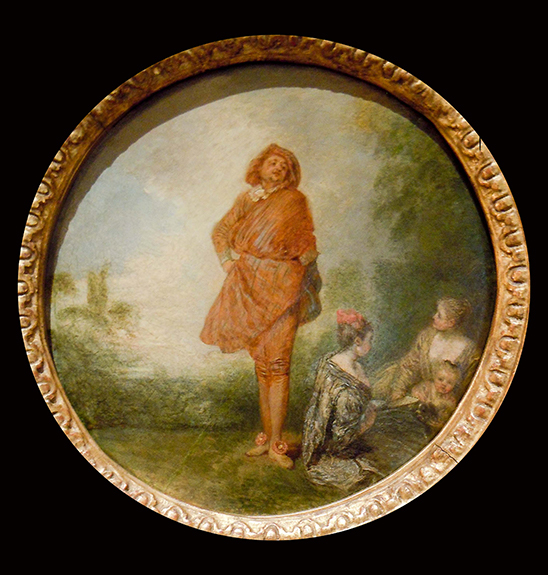
Watteau, L’Orgueilleux.
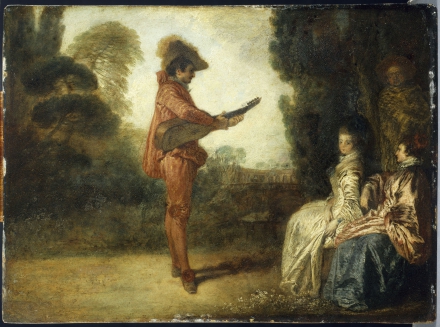
Watteau, L’Enchanteur, oil on copper, 18.9 x 25.5 cm. Troyes, Musée des beaux-arts.
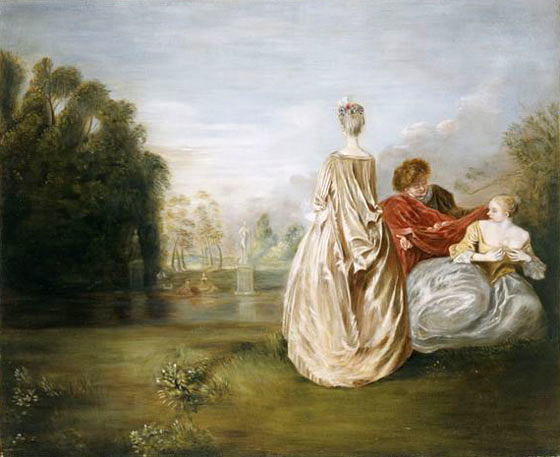
Watteau, Les Deux cousines, oil on canvas, 30.4 x 35.6 cm. Paris, Musée du Louvre.
Also notable is the marked asymmetry of the composition. Although it might seem a novel solution, in fact, Watteau employed such asymmetrical compositions throughout his career. It was already present in his early L’Enchanteur and was used to great advantage in Les Deux cousines. In these and other examples, although the figures are to one side, they are balanced by trees in the middle ground. In L’Orgueilleux, on the other hand, the foliage at the left is minimized, making the asymmetry even more marked.
Click here for copies of L’Orgueilleux.